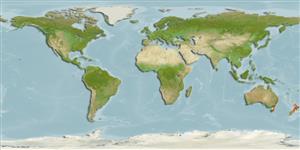Malacostraca |
Decapoda |
Palinuridae
Environment: milieu / climate zone / depth range / distribution range
Ecology
Benthic; depth range 0 - 155 m (Ref. 4). Subtropical, preferred 14°C (Ref. 107945); 26°S - 47°S, 146°E - 173°W (Ref. 4)
Indo-West Pacific.
Length at first maturity / Size / Weight / Age
Maturity: Lm 15.5, range 14 - ? cm Max length : 61.0 cm TL male/unsexed; (Ref. 89420); common length : 30.5 cm TL male/unsexed; (Ref. 89420)
Carapace length: 25 cm; total body length: 38 to 56 cm and carapace lengths: 16 to 24 cm (ovigerous females) (Ref. 4). Inhabits substrates of sand, gravel or rocks. Smaller specimens seem to be more frequent on rocky bottoms (Ref. 4). Phyllosomas are opportunistic predators. Early stage phyllosomas are suited to ingest soft prey such as polychaete worms, medusae and ctenophores, while later stages may consume fish larvae and mussel flesh. In general, lobsters are opportunistic feeders, consuming a variety of sessile invertebrates (Ref. 105202).
Life cycle and mating behavior
Maturity | Reproduction | Spawning | Eggs | Fecundity | Larvae
Females are ovigerous from late September to January (Ref. 4).
Holthuis, L.B. 1991 FAO Species Catalogue. Vol. 13. Marine lobsters of the world. An annotated and illustrated catalogue of species of interest to fisheries known to date. FAO Fish. Synop. 125(13):292p. Rome: FAO. (Ref. 4)
IUCN Red List Status
(Ref. 130435: Version 2025-1)
CITES status (Ref. 108899)
Not Evaluated
Not Evaluated
Threat to humans
Human uses
Fisheries: commercial
FAO - Fisheries: landings | FishSource | Sea Around Us
Tools
More information
Trophic EcologyFood items (preys)
Diet composition
Food consumption
Predators
Population dynamicsGrowth
Max. ages / sizes
Length-weight rel.
Length-length rel.
Length-frequencies
Mass conversion
Abundance
PhysiologyOxygen consumption
Human RelatedStamps, coins, misc.
Internet sources
Estimates based on models
Preferred temperature
(Ref.
115969): 14.5 - 21.6, mean 15.8 (based on 108 cells).
Fishing Vulnerability
Moderate vulnerability (44 of 100).
Climate Vulnerability
Moderate to high vulnerability (49 of 100).
Nutrients : Calcium = 109 [35, 184] mg/100g; Iron = 1.59 [1.21, 1.97] mg/100g; Protein = 20.2 [19.2, 21.3] %; Omega3 = 0.285 [0.185, 0.386] g/100g; Selenium = 48.3 [-31.7, 128.3] μg/100g; VitaminA = 0 μg/100g; Zinc = 1.79 [1.17, 2.40] mg/100g (wet weight); based on
nutrient studies.
